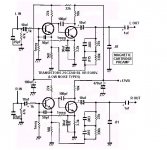Take a look at Rod Elliot's website, specifically P05-Mini & Hi-Fi RIAA Phono Preamp they work just fine.
Regards,
Kevin
Regards,
Kevin
Another very highly regarde phonopre is salas‘ simplistic...
Not simple at all but very very nice people accompanying it, and if you’re really careful in close range of your budget-limit...
https://www.diyaudio.com/forums/analogue-source/129126-simplistic-njfet-riaa.html#post1600160
Not simple at all but very very nice people accompanying it, and if you’re really careful in close range of your budget-limit...
https://www.diyaudio.com/forums/analogue-source/129126-simplistic-njfet-riaa.html#post1600160
As to my previous MM schematic posted, I've found that "simple" is the best.
The signal only has to get though 2 transistor junctions, much less than the usual op amp IC.
And being less junctions, means more "signal purity" and less negotiating around of the signal.
Remember, every junction can and does add its own flavor, and needing correction.
So a "straight wire with gain" is the ultimate to strive for.
The signal only has to get though 2 transistor junctions, much less than the usual op amp IC.
And being less junctions, means more "signal purity" and less negotiating around of the signal.
Remember, every junction can and does add its own flavor, and needing correction.
So a "straight wire with gain" is the ultimate to strive for.
"Simple" and "simplistic" are quite different things.
With the pejorative connotations of the latter I never understood the use of the moniker here.
On the other hand elegance is attractive.
Maybe Einstein has something to add here? Or Bill Occam??
With the pejorative connotations of the latter I never understood the use of the moniker here.
On the other hand elegance is attractive.
Maybe Einstein has something to add here? Or Bill Occam??
If you're worried about transistor junctions messing up the sound, the best you can do is use tubes instead of transistors and the second best is putting as many stages in the negative feedback loop as needed to maximize the loop gain over the band of interest; the more loop gain, the less sensitive a feedback amplifier gets to the distortion of its active part.
That said, I'm sure all RIAA amplifiers in this thread will work just fine. The only phono amplifier that is designed so poorly I would advice against it is the moving-magnet version of the Elektor Supra 2.0, particularly the version with LT1028's: Elektor used a fortune's worth of ultra low voltage noise op-amps to make the highest current noise moving-magnet amplifier on the planet.
That said, I'm sure all RIAA amplifiers in this thread will work just fine. The only phono amplifier that is designed so poorly I would advice against it is the moving-magnet version of the Elektor Supra 2.0, particularly the version with LT1028's: Elektor used a fortune's worth of ultra low voltage noise op-amps to make the highest current noise moving-magnet amplifier on the planet.
- Home
- Source & Line
- Analog Line Level
- finding a phono preamp..

